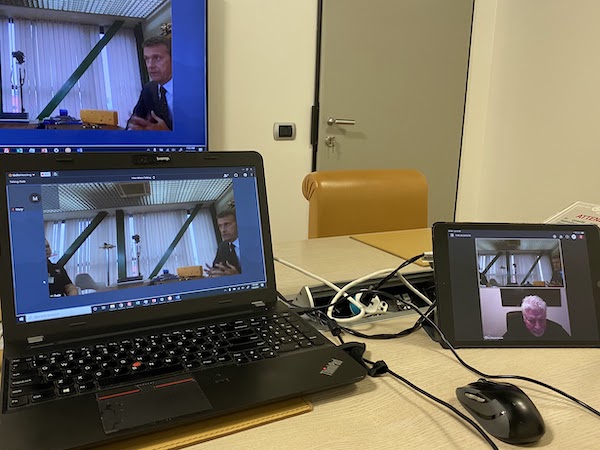Engineer’s ERV static-plate enthalpy cores specification eliminates need for conventional defrost systems and saves city energy and maintenance costs The new $12 million Wasilla (Alaska) Police Station employs many innovative HVAC designs that will save the city energy and provide occupants with unprecedented indoor air quality (IAQ). The recently completed 20,000-square-foot building designed with aesthetic Read more
Featured
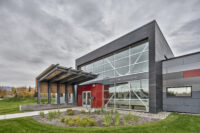
Engineer’s ERV static-plate enthalpy cores specification eliminates need for conventional defrost systems and saves city energy and maintenance costs
The new $12 million Wasilla (Alaska) Police Station employs many innovative HVAC designs that will save the city energy and provide occupants with unprecedented indoor air quality (IAQ).
The recently completed 20,000-square-foot building designed with aesthetic post-modern industrial architecture by MCG Explore Design, Anchorage, doubles the police department’s previous building, which was an old, converted bank. The sustainable mechanical HVAC design features dedicated outdoor air systems (DOAS) with energy recovery, hydronic radiant floor heating and packaged rooftop units (RTU) with heat recovery that all contribute to energy efficiency.
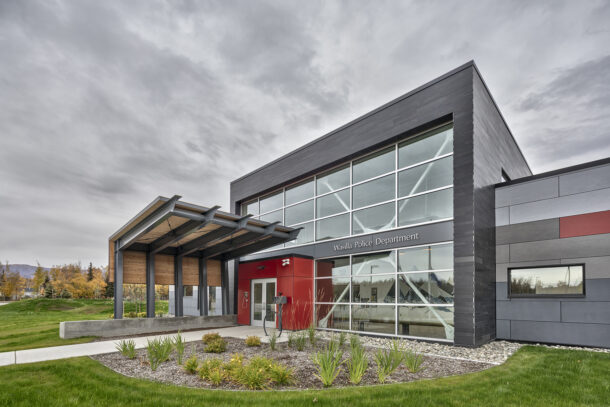
For example, ERVs were specified without defrost coils, which are commonly used for Alaska’s frigid winters, but are costly in upfront capital, operational and maintenance costs. Instead, DN Series DOAS units manufactured by RenewAire, Waunakee, Wis., use static-plate enthalpy cores. The units are designed to operate down to -10°F ambient temperatures without requiring defrost cycles, because they don’t transfer H2O between supply and exhaust air. If temperatures drop lower (Wasilla temperatures rarely drop below -20°F), the DN-Series’ onboard controller activates a bypass damper and introduces space heat to prevent heat exchanger frost accumulation, if needed, according to Christian Dougherty, P.E., mechanical engineer and the project’s manager at consulting MEP engineering firm, AMC Engineers, Anchorage, Alaska.
“The energy recovered by the DOAS units, and the fact they don’t require conventional defrost cycles and equipment, is saving the city a large amount of money,” said Dougherty, whose firm has specified core-based units on previous projects. “We’ve had mixed results in the past with energy recovery alternatives, such as enthalpy wheels, that require defrost cycles and maintenance for moving parts that cores don’t require.”
“Cores aren’t subject to cross contamination, which is potentially problematic in critical spaces, such as garages and evidence rooms, where contaminants can potentially infiltrate occupied spaces,” added Jordan Privoznik, systems sales leader at Trane, Anchorage, Alaska. “DOAS units with static-plate cores are often an ideal solution in our environment as they can be more reliable than other energy recovery methodologies due to less moving parts, while still achieving very high efficiencies.”
Installed by project mechanical contractor Mechanical Specialists Inc., Wasilla, Alaska, the two DN Series ERVs provide 3,000-CFM and 1,700-CFM of 100% outdoor air in the facility’s 3,100-square-foot garage and the 750-square-foot evidence room, respectively. Both spaces are under negative pressure to prevent garage vehicle emissions and evidence room odors, such as bodily fluids or confiscated drug off-gassing, from infiltrating common walls shared with occupied spaces. The two units are also outfitted with sensors, an onboard controller, a manual wall switch and a smoke detector, the latter which complies with Alaska building code. The facility’s building management system (BMS), a Trane Tracer Control System, monitors the ERVs.

While evidence material off-gassing was the prime motivation, 100% outdoor air will also dilute any airborne contaminants that could degrade stored evidence. The evidence room is also closely monitored to minimize any potential degradations from wide temperature and humidity variances.
The garage’s 100% outdoor air is critical in preventing CO and NO2 accumulation and maintaining indoor air quality for employees using and servicing city vehicles. The ERV uses energy recovery to help maintain a year-round 70°F set point. On extreme cold days, which according to ASHRAE guidelines is -23°F locally, the ERV can preheat air to as high as 40°F. A 70°F leaving air temperature can be reached on extreme days by using the integral hydronic reheat coil supplied by the boiler circuit’s glycol heat exchanger.
Other project equipment includes a 25-ton, 8,500-CFM Trane Intellipak™ RTU that supplies the building and includes DX cooling, hydronic heat, and variable airflow, serving several Trane variable air volume (VAV) boxes with hydronic reheat coils to provide precise zone control. A 15-ton, 5,000-CFM Trane Voyager™ RTU was also specified. Radiant floor heating, and snow melt duties are provided by a 2Mbh gas-fired boiler manufactured by Riello, Mississauga, Ontario. Secondary glycol heat exchangers for air handlers were provided by Bell & Gossett, Morton Grove, Ill.
Additional efficiency was created by a Dougherty and Privoznik collaboration that configured the radiant floor heating into zones (rooms) controlled by the Trane BACnet Building Automation System. While VAVs and radiant heating can operate concurrently, there exists a challenge when combining VAV technology’s quicker space comfort achievement with radiant tubing embedded in a thermal mass that takes longer to react. “Meticulous programming and strategic commissioning were required to ensure both systems operated seamlessly and synergistically,” explained Privoznik. “This process, combined with Trane’s advanced Trim and Respond control strategies as prescribed in ASHRAE Guideline 36, allowed us to maximize energy efficiency, maintain control stability and achieve optimal space comfort for the occupants.”
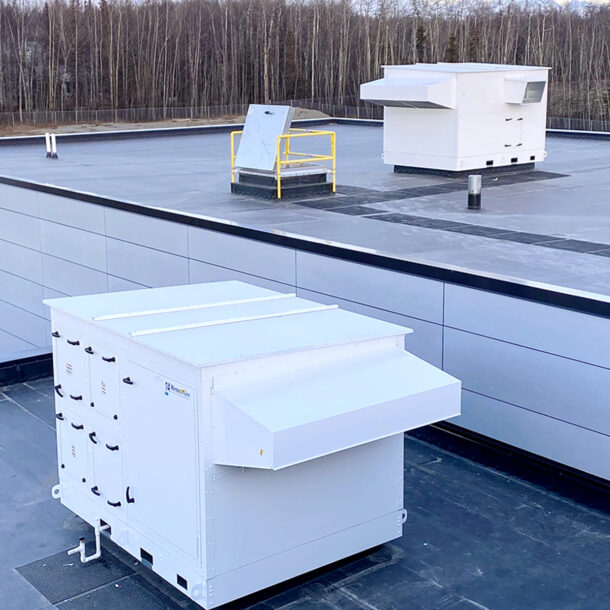
Another energy efficient design was Dougherty’s collaboration with Trane for designating one air handler for operation only during standard business hours, while the other unit operates for 24/7 occupied areas. When a large portion of the building is unoccupied, and outdoor air isn’t required, the less efficient VAV System is disabled and space temperature is maintained solely thru radiant floor heating.
Although the project didn’t apply for Leadership in Energy and Environmental Design (LEED®), Dougherty said the HVAC design would have significantly helped the building accumulate enough credits if the city had chosen certification.
Regardless, the police station is delivering 21st century comfort, IAQ and energy savings, within a strict construction budget.
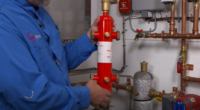
Foley Mechanical worked with the owner of a 1920 home in the Cleveland Park section of Washington, D.C. on a heating system upgrade. The project included a 95% AFUE condensing gas boiler that replaces an existing conventional cast iron gas boiler. https://youtu.be/O_rQ1JOw6f0 Resideo hydronic products that are highlighted included the following: Hydro-Separator ECM Pumps Zone Read more
Foley Mechanical worked with the owner of a 1920 home in the Cleveland Park section of Washington, D.C. on a heating system upgrade. The project included a 95% AFUE condensing gas boiler that replaces an existing conventional cast iron gas boiler.
Resideo hydronic products that are highlighted included the following:
- Hydro-Separator
- ECM Pumps
- Zone Valves
- Relay Controls
- Expansion Tank
- Fill Valve and Backflow Preventer
Radiant floor heat was added to a new basement concrete slab. The existing cast trim radiators on the three upper floors were RE-piped and RE-valved. Foley Mechanical used this opportunity to zone by floor using Resideo zone valves. Nearly six months in and in February the owner shared that he had never been more comfortable in his home.
For more information about the Resideo products in this sponsored installation, please visit HERE.
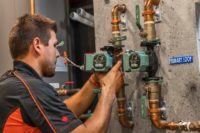
In our continuing Industry Forecast series, we talk with John Hazen White, Jr. – Executive Chairman & Owner of Taco Comfort Solutions, on topics such as the short-term economy, supply chain issues, and lessons learned over the course of the pandemic. Here is our exclusive Q & A with John Hazen White, Jr.: Read more
 In our continuing Industry Forecast series, we talk with John Hazen White, Jr. – Executive Chairman & Owner of Taco Comfort Solutions, on topics such as the short-term economy, supply chain issues, and lessons learned over the course of the pandemic. Here is our exclusive Q & A with John Hazen White, Jr.:
In our continuing Industry Forecast series, we talk with John Hazen White, Jr. – Executive Chairman & Owner of Taco Comfort Solutions, on topics such as the short-term economy, supply chain issues, and lessons learned over the course of the pandemic. Here is our exclusive Q & A with John Hazen White, Jr.:
MH: We’ve all experienced supply chain shortages, whether it’s industry related or things such as computer chips, plastics, bacon, etc., for example. Do you project a turnaround soon or within the next 6-12 months for certain materials that relate to your specific company?
JHW: Due to the China’s current COVID lockdowns and further supply chain disruptions caused by the war in Ukraine, we believe that chain issues are going to get worse over the next several months. Much of the processing of base raw materials and secondary materials has been shut down, further straining the supply chain. Exacerbating these issues, the skyrocketing costs of fuel and transportation are going to make the delivery of goods more costly.
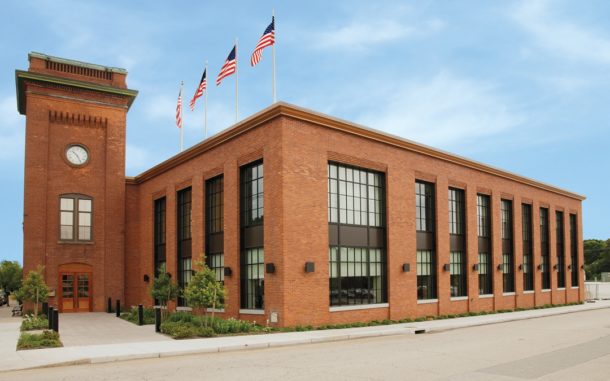
MH: We are in the midst of some of the highest inflation rates since the early ‘80s. Do you think that higher inflation becomes a “newer normal”? Explain.
JHW: Eventually costs will temper demand and inflation will slow. Unfortunately, this will be accompanied by an economic downturn. The risk is that governments may try to artificially stimulate the economy, which could potentially prolong the inflationary upturn.
MH: In general, how do you see the economy short-term? Give a few examples of how you draw that conclusion (housing starts, commercial construction, etc.).
JHW: The short-term economy appears to be healthy. Orders remain strong and backlogs are at all-time highs. Data such as housing starts point to continued growth in 2022, with low inventory levels and a tight rental market driving that growth. In addition, manufacturing construction is on the rise to meet capacity demands.
MH: Where are you seeing signs of positivity, if any?
JHW: Short-term, the economy appears to still be growing, but at a slower pace. Although the last two years have been very challenging, these challenges can also serve as a catalyst for improvement. Companies are reinventing their structures and processes to adapt to a much faster business pace. We’re seeing step changes in productivity, efficiency, and innovation to keep up with today’s challenges and changing business environment.
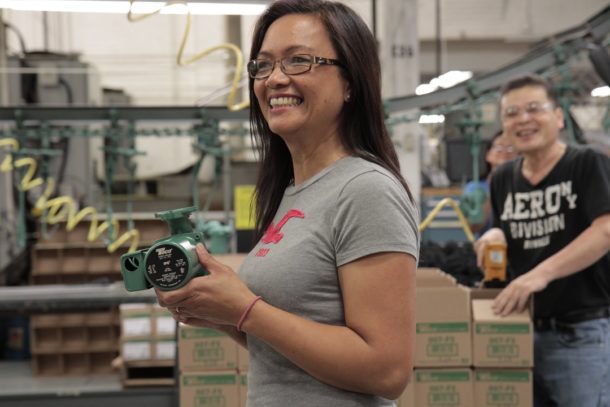
MH: How do you as manufacturers work with customers who are dealing with longer lead times and/or higher prices? Is it a matter of open lines of communication?
JHW: Constant communication and strong partnerships are great ways to manage through the current supply chain and production issues. Most customers understand the challenges that all manufacturers are currently dealing with – they just want to be kept informed to minimize surprises and plan their projects accordingly.
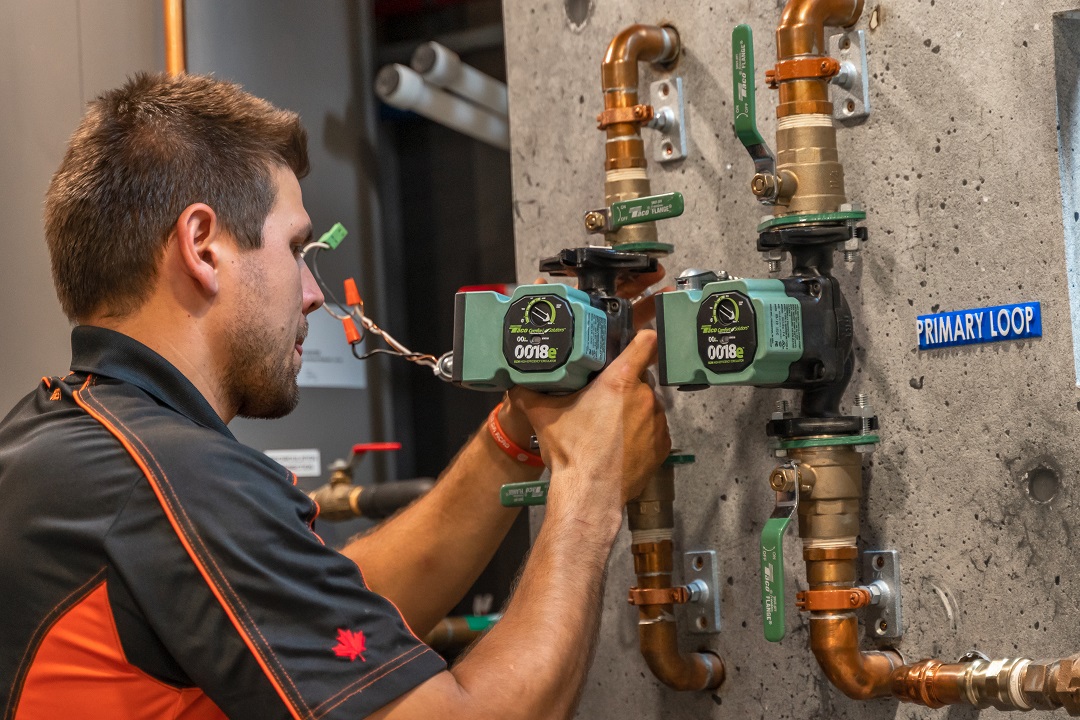
MH: It seems that in today’s employment landscape, it’s hard to find good labor, whether it’s truck drivers, waiters at restaurants, etc. In our industry, how do we continue the fight to highlight the trades as a great career choice?
JHW: Social media is a great way to reach future tradesman of our industry. We have been running a social media campaign called #TradePower, which highlights successful contractors in the industry and the pride they take in their craftsmanship and service. Above all else, Taco has benefited by continuing to do what we always do – treat people right.
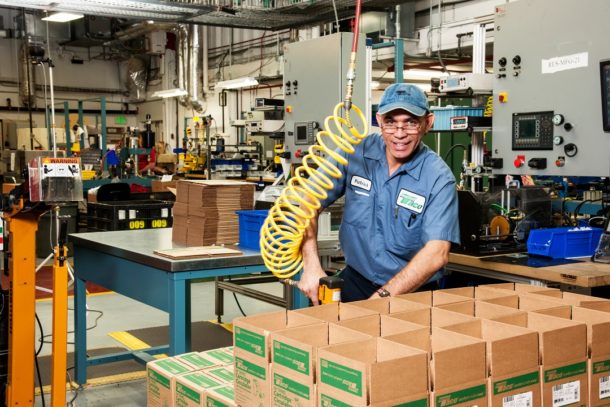 MH: In spite of COVID, people must move on. How has your company evolved—or continued to march forward—over the past two years, and talk about any new initiatives, expansions, etc.
MH: In spite of COVID, people must move on. How has your company evolved—or continued to march forward—over the past two years, and talk about any new initiatives, expansions, etc.
JHW: The sudden disruption of COVID restrictions in 2020 forced a much faster adoption of planned technology upgrades. A planned rollout of organizational digitization was condensed from 18 month to two weeks, which gave us the ability to continue functioning and growing in the new work-from-home reality. One of the biggest positives we saw during the pandemic was the rise of global collaboration. The quick adoption of virtual meetings boosted our collaboration with our entire global workforce, ensuring the best players were part of any team meeting. This has led to an increased sharing of ideas on everything from safety protocols to operational improvements. More than ever, we are thinking globally to optimize our resources and maximize our growth.

The importance of inventorying the right tools + supplies Last year, Keefer Rader, owner of Albuquerque-based Outlaw Mechanical, a shop that specializes in light commercial work, including kitchens, had one of those experiences that confirmed the value of an investment he’d made just weeks earlier. Well, he didn’t buy cryptocurrency or Spotify stock at just Read more
The importance of inventorying the right tools + supplies
Last year, Keefer Rader, owner of Albuquerque-based Outlaw Mechanical, a shop that specializes in light commercial work, including kitchens, had one of those experiences that confirmed the value of an investment he’d made just weeks earlier.
Well, he didn’t buy cryptocurrency or Spotify stock at just the right time if that’s where your imagination was going with it.
The event that triggered confirmation of a diagnostic tool’s purchase was a visit to a popular wedding venue in Colorado, a full day’s drive (or night, in this caser) from his shop.
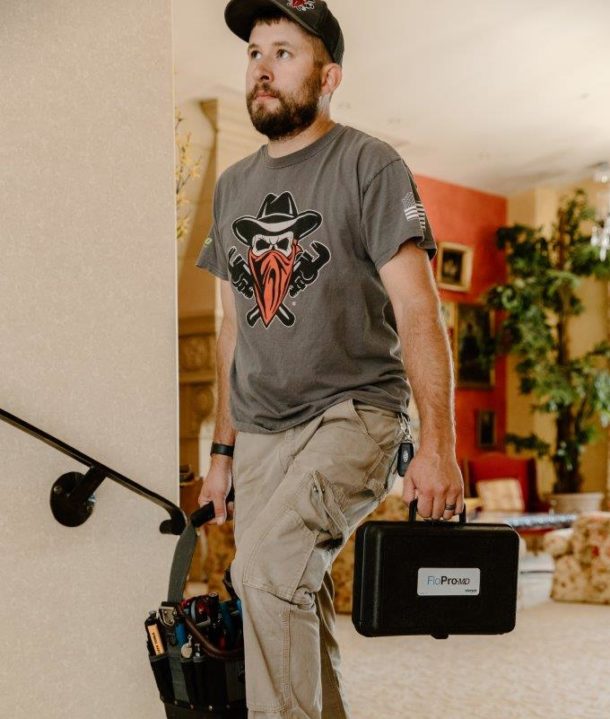
Keefer Rader, owner of Outlaw Mechanical.
350 miles from home base
Several years before he founded Outlaw Mechanical at the age of 21, Rader worked in remote Colorado, maintaining the property and mechanical systems on a private ranch – a destination that’s won recognition as a luxurious wedding/events venue. Though his firm – now 15 years old – has won recognition as the “Number Two-rated” mechanical firm in Albuquerque, he’s maintained ties in Colorado.
“My family and I love the area, and there are still folks in Colorado who insist that I serve as their mechanical systems pro – even at a distance of 350 miles,” he said. So it wasn’t a complete surprise to hear from a man who manages a mountaintop wedding venue outside of Durango, CO – just several days before a large gathering was to lease the facility for a ceremony.
Apparently, a large kitchen broiler – “absolutely needed by the caterer,” he said – wasn’t performing well. The new manager was instructed to get Rader out to fix it.
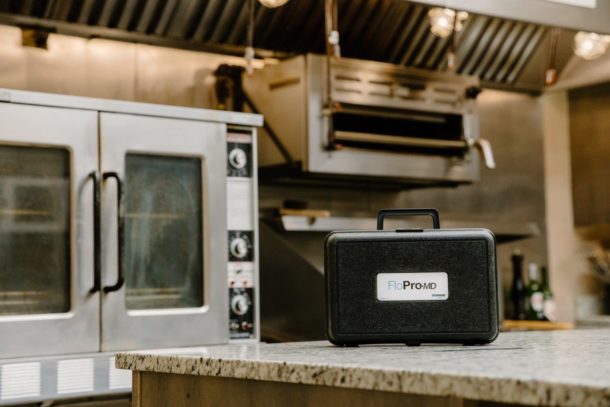
The Watts/Dormont Flo0Pro-MD is protected by its own hard case, and is easily portable.
“I tried to help him diagnose and trouble-shoot the problem, but I quickly learned that they’d already attempted to solve the problem [to no avail],” said Rader. “So, with less than a week before the large group arrived for the wedding – and with plenty of work to do in Albuquerque – Rader swept his schedule to allow time for a Friday night drive to Durango, hoping to have the problem solved for a drive home the next day.
“The challenge with remote site work is the need to pre-think everything,” he added. “Would I have the right materials and supplies and spare parts with me, and anything else I might need to complete the job in one trip?”
By Friday afternoon, Rader visited a local supplier, buying some spare parts for the large, commercial kitchen broiler. He ran between the truck and his shop’s well-stocked shelves a dozen times before his departure and was soon on his way, driving most of the distance that evening.
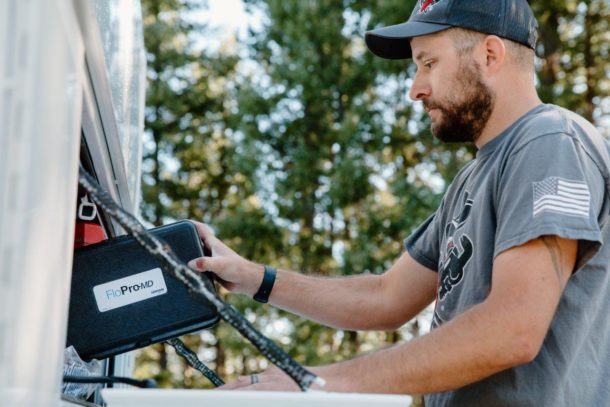
Keefer Rader, owner of Outlaw Mechanical, retrieves the FloPro-MD from his truck.
The next day, Keefer drove the last 20 miles to the wedding venue. “Just after sunrise, the site was open just as the manager promised,” said Keefer. He quickly found the griddle and set to work.
“I found that the broiler worked, but not well enough. It needed more [LP] gas for more heat,” he explained. Rader was unable to use a conventional manometer as the broiler didn’t have the test ports that he typically used for diagnosing hydronic boiler problems.
He went to the truck for the FloPro-MD diagnostic tool. “It’s now one of my go-to tools for gas appliance work,” he said. “The FloPro showed that the pre-regulator gas flow and pressure were good, but on the regulator’s other [outgoing/supply] side, I began to see my problem.”
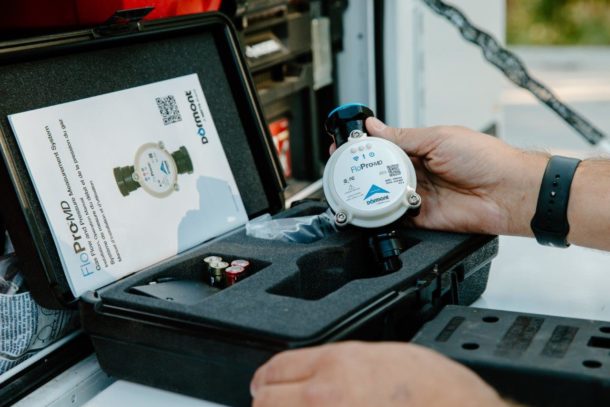
The Watts/Dormont FloPro-MD is a portable 3-in-1 gas flow meter, digital manometer, and calculator that helps service technicians and installers perform equipment start-ups, commissioning, and quickly diagnose gas flow or gas pressure issues with gas-burning appliances.
Among the supplies Rader learned long ago to keep in his truck: several gas regulators. “The FloPro made it perfectly clear that the broiler’s regulator had failed. Once connected, the new regulator provided greater gas pressure to the broiler which worked as intended, with plenty of heat for the caterer set to arrive that afternoon.”
Rader explained that, as the tool is connected to the gas line, and is out of the way, he especially likes the [FloPro-MD’s] ability to diagnose problems while the appliance is operating. “Managers at most commercial kitchens refuse to allow trouble-shooting or maintenance work during hours of operation because of the need to shut the appliance down – or, even worse – to cut gas service at a manifold to several gas appliances. Not with this tool – it’s designed to work while the appliance is in use.”
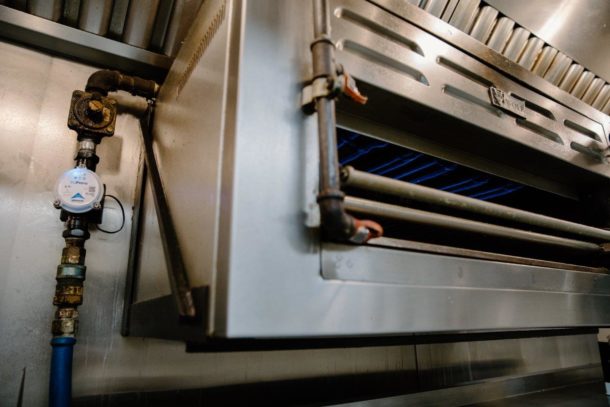
The FloPro-MD performs its diagnostic tasks, and provides useful data, while in-line (as gas courses through it). Here’s the device, in place, while flames heat the griddle following Keefer’s successful fix.
“The FloPro does the work of a variety of other tools,” added Rader. “It offers the function and intelligence of a manometer, and a gas flow meter, too. It offers precise diagnostics, with plain English on the screen. My hat’s off to the [tool’s] designer. The FloPro now has a permanent place in my truck.”
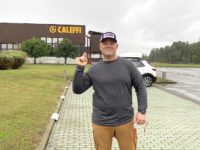
Starting over 60 years ago in a small province in northern Italy, Caleffi has increased its footprint, expanded its international presence, survived the current pandemic, all the while manufacturing some of the most innovative PHVAC, heat metering and renewable products in the world. This past fall, Mechanical Hub was honored to tour the Caleffi S.p.A Read more
Starting over 60 years ago in a small province in northern Italy, Caleffi has increased its footprint, expanded its international presence, survived the current pandemic, all the while manufacturing some of the most innovative PHVAC, heat metering and renewable products in the world.
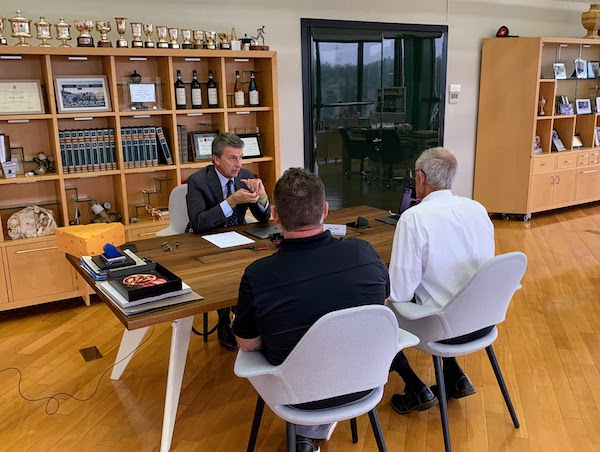
Chairman Marco Caleffi talking with Bob ‘Hot Rod’ Rohr and MH’s Eric Aune, while on an overseas video call with MH’s John Mesenbrink.
This past fall, Mechanical Hub was honored to tour the Caleffi S.p.A. global headquarters in Fontaneto d’Agogna, Italy. We were joined by Bob “Hot Rod” Rohr, Training and Education Manager, Caleffi North America. Afterward, we sat down to chat with Chairman Marco Caleffi. To break the ice, we asked Marco what type of sports he enjoys watching, whether it be American football or European soccer. Marco promptly reached to the shelf behind him and put a vibrant yellow cheese wedge on his head, signifying his admiration for the Green Bay Packers and solidarity with Caleffi’s North American headquarters, located in Milwaukee, Wisconsin. In disbelief and shock—as I am a Chicago Bears fan—I appreciated the gesture, but I needed to change the subject, and quickly!
A Taste of Caleffi
Upon arrival we were greeted with an impactful historical display of how Caleffi S.p.A.’s site was first constructed and the many expansions it has experienced in the decades since. During our walking tour, we were led through the entire manufacturing process—from the brass bar stock to final packaging of literally thousands of catalog offerings. “I’ve been on a fair number of factory tours, but I can say none showcase new technology and innovative manufacturing methods quite like Caleffi did,” said Eric Aune, co-owner, Mechanical Hub.
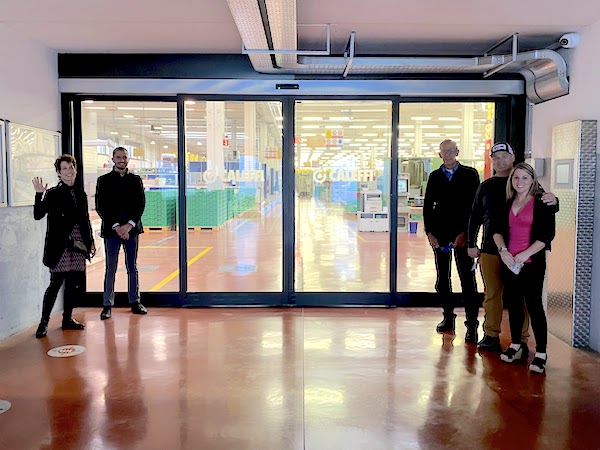
Standing at the entrance to the plastics manufacturing plant, from left: Ellen Rohr, Fabio Rossi, Hot Rod Rohr, Eric Aune & Heather Aune.
With all the technology, synchronization and automated machinery, there still exists a proud workforce that is instrumental in the final product sold to plumbers, HVAC techs and other contractors around the world. “It was so cool to meet the people responsible for the products we buy every day. Equally as impressive, we were able to watch the process as literally every product Caleffi manufactures is tested before final packaging ships. I was blown away—the tour and people are first class all the way,” said Aune.
60 Years of Leadership
In 1961, beginning with two small lathes in his basement used for parts he crafted for OEMs, Francesco Caleffi founded the company. Fast forward to today and the Caleffi Group has grown to employ 1,400 people worldwide with subsidiaries and commercial offices in 18 countries. It produces and moves products via four Italian manufacturing and logistics facilities. Unlike other companies that are in the third or fourth generation, Francesco started from the beginning. “My father was like a hurricane. To be honest, he was able to build Caleffi in only one generation,” said Marco Caleffi.
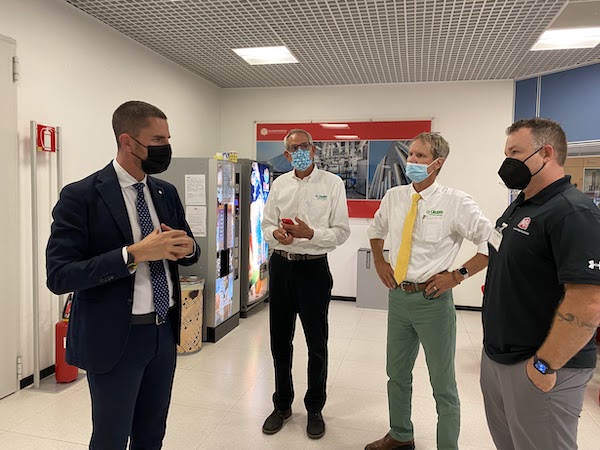
Fabio Rossi about to give the Caleffi tour with Hot Rod, Mark Olson and Eric Aune.
Marco boasts that his father was a good mechanic, personally machining items and producing spare parts for other companies. “After two years, my father decided to make new, finished products such as air vents and safety valves,” said Marco. As technology advanced, automation became a big factor in the company’s success, a key contribution Marco’s father pushed for. “With forward-thinking automation, we have far greater control over quality. The standard of consistency is much, much better than manned assembly.”
From the beginning, what set Caleffi apart from competitors was “while they were only making ball valves, fittings and manifolds we were much more focused on the needs of the systems while making valves, fittings and manifolds,” continued Marco.
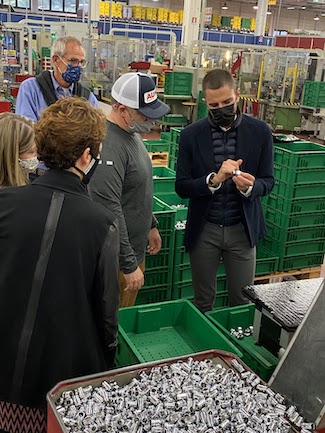
Fabio showing the details of how every catalog item is tested before leaving the plant
Early in Caleffi’s development, an instrumental partnership was formed. Marco’s uncle, Dante Bonini, joined Francesco Caleffi and was responsible for building a new commercial division. According to Marco, the two created a nice collaboration and they were a good balance for each other. “My father was difficult to manage because he wanted new buildings, new facilities and new investments before we needed them,” chuckled Marco.
Bonini offered a calming temperament that assisted Caleffi in making strategic moves when the time was right. “When we moved from the Gozzano regional plant in the Italian province of Novara, we bought this piece of land with room to grow in Fontaneto. It is still our headquarters today. Since the day we arrived, it has been our intention to expand,” said Marco.
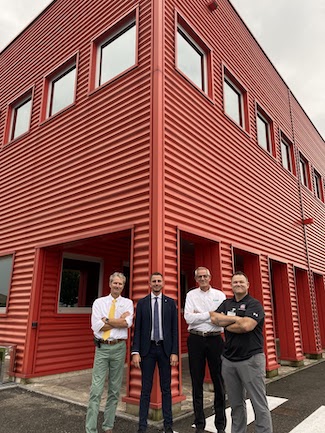
In front of the CUBOROSSO (from l to r): Mark Olson, Fabio Rossi, Hot Rod Rohr and Eric Aune.
In 2008, Caleffi opened its new research center, named CUBOROSSO, a bright red building where products are researched, developed and tested. It is a building that stands in stark contrast with the others on the Caleffi campus. “It represents the color of the Italian mechanical ‘soul,’” said Marco. “Like Ferrari, Ducati and Alessi, red represents the mechanical side of Italian innovation.
In 2009, Caleffi continued its investment in innovation with its completely unmanned Automatic Vertical Warehouse (MAV), which improves customer service by optimizing logistical processes. When the storage and handling of goods are entirely automated, the result is shorter processing times and minimized operator error—the standard quality aforementioned by Marco. “It is critical to have finished products for delivery and spare parts for what is needed in assembly,” said Marco.
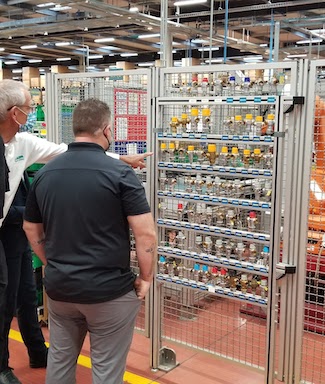
Checking out the “wall” of mixing valves.
“Everyone said it was so clean and modern, but it’s not until you’re on the floor and walking around that you realize you don’t see piles of materials and parts,” observed Aune. “Everything is very organized to the point where in the assembly stations, they move only the materials they need for a certain amount of time and a certain amount of product and then move them out quickly to be replaced with the next product. Everything was very orderly. It seemed that everything had a place. You could tell that that’s how they operate every day, not just because we were touring.”
If You Build It, They Will Come
In the 1980s, Caleffi was ready to expand into Europe and opened its first subsidiary in Germany. By the 90’s, another followed in England. “When we decided to expand, the initial branch was targeted for Germany because it’s a country that is associated with the ‘mechanic’s reference for innovative, precisely manufactured technology.’ There are a lot of German car makers, valve producers and boiler companies. We experienced nice success in Germany and then expanded into England. Now, 25 years later, we continued making our way into the U.S. and Canadian markets,” said Marco.
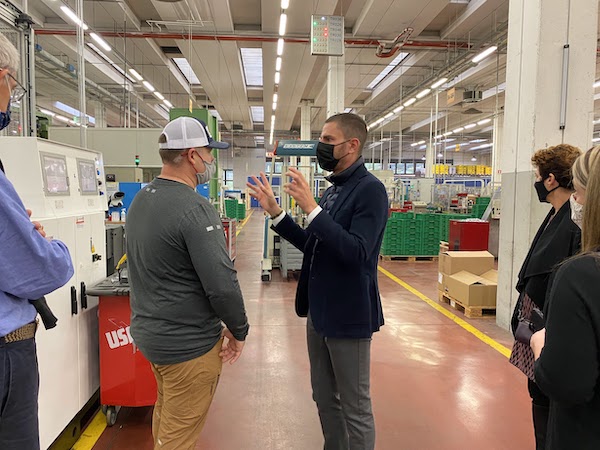
Fabio conducting the tour.
That introduction into North America came in 2001 when Roger Michaud and Rex Gillespie joined with Caleffi S.p.A. to begin pioneering the market. Mike Schreiner, now Chief Technology Officer, signed on in 2003 to develop a new zone valve line which ultimately became a key factor in Caleffi’s early growth.
From Caleffi S.p.A., Sergio Casarino was appointed Area Export Manager responsible for North America. He became an expatriate and for two years lived in Milwaukee to help get the fledgling business off the ground. Giovanni Monti, now General Manager, strategically positioned the growing world-wide company, providing a balanced configuration of management expertise and direction.
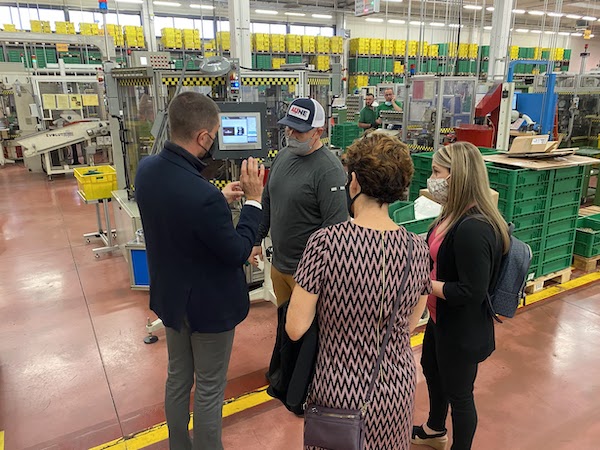
To further accelerate growth and organize North America for expansion, veteran Mark Olson was hired as CEO in 2005 where he continues to serve. Caleffi then began bringing on seasoned hydronic and plumbing experts such as Bob “Hot Rod” Rohr to head training and Roger Corrente to head sales.
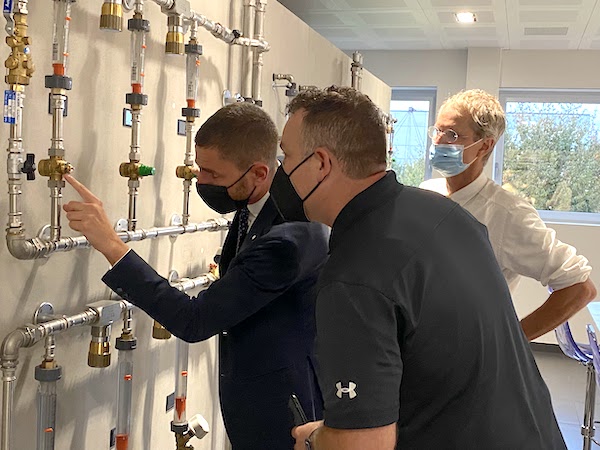
Working piping systems are on display in the CUBOROSSO training center
Marco explains, “Once the decision to expand into North America was made, we were committed to deeply understanding the unique design elements in their hydronic and plumbing systems. We rejected the idea that we had to introduce this Italian valve or that Italian valve. If you understand the system needs, you can then devise better products for that market. With the balance of the right product configurations and management expertise, we are finding success in the North American market. It’s not easy when an Italian company goes elsewhere—such as to the U.S.—to find success.”
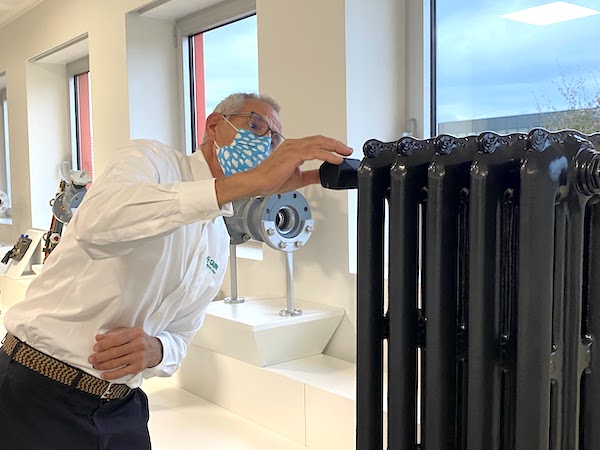
Hot Rod closely inspecting a radiator.
Bob Rohr further explains, “We’ve seen companies come into the U.S. and say ‘you’re going to do it the way we do it in our home country’ and most often it doesn’t work. Mark was smart to emphasize listening and observing: what do the American products need to be? A big part of our success is listening to the market instead of taking our way of doing business in some other place of the world and trying to force it into the market.”
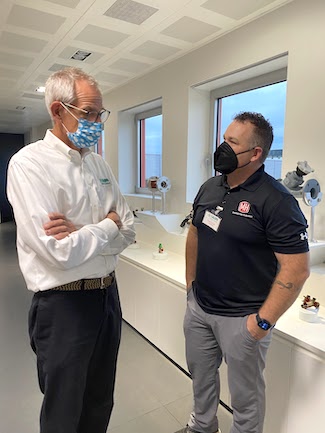 To that point, training plays an integral role. Commented Marco, “We must learn and teach the system needs of our markets. In North America, applying the experience and reputation of experts like Hot Rod makes it much easier to extend our success. I think Bob and other veterans we hired have been key factors to our success.”
To that point, training plays an integral role. Commented Marco, “We must learn and teach the system needs of our markets. In North America, applying the experience and reputation of experts like Hot Rod makes it much easier to extend our success. I think Bob and other veterans we hired have been key factors to our success.”
“Before Mark Olson came on board, our focus didn’t extend much beyond simply selling. Mark brought a technical and market-based mindset. With his influence, we became more organized and stable. Today we have a premium market reputation with a deep technical staff and strong after sales support. With around 50 employees in the States, it’s almost like another company,” said Marco.
A COVID Epicenter
Early in 2020, Italy was one of the first countries ravaged by COVID-19. Caleffi was proactive even before the government shutdown. “Two days before the Italian government shut down all production, I personally decided to halt production because it was too difficult. The hospitals were full of patients. There were people working in the office and in production without knowing what could happen. It was a tough time, to be honest,” said Marco.
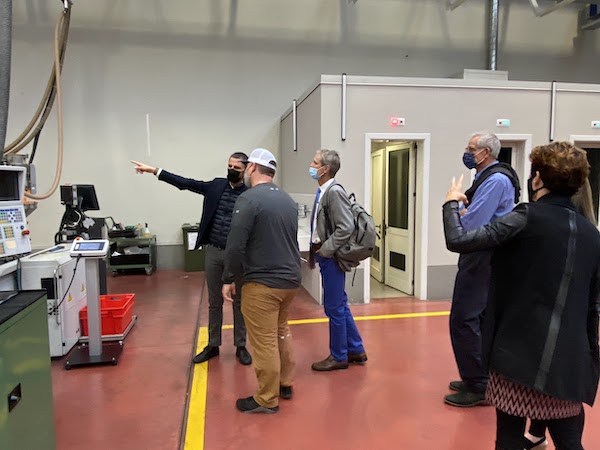
But then something powerful happened. “After staying home for two or three weeks, people wanted to come back to the company, which I never expected. Plenty of people were dedicated to the company, and it’s these employees that make up the soul and the environment of the company,” said Marco. Subsequently, Caleffi increased production in May, June and July of that year, running two shifts per day throughout the rest of the year.
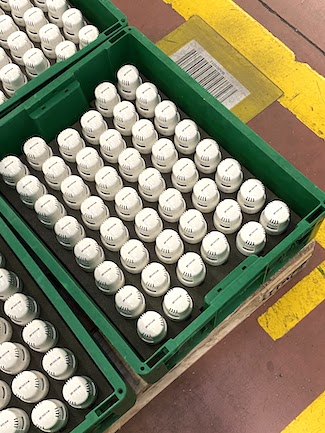 “Especially now,” Marco said, “I feel proud of the choices we’ve made in the last decades in terms of business organization. Giovanni Monti is no doubt our key leader as he steadily positions and implements improvements year after year with his business resolution and experience as Managing Director for Caleffi. Giovanni is able to keep every process under control while mindfully planning actions with accuracy. It is an essential approach as we move beyond COVID.”
“Especially now,” Marco said, “I feel proud of the choices we’ve made in the last decades in terms of business organization. Giovanni Monti is no doubt our key leader as he steadily positions and implements improvements year after year with his business resolution and experience as Managing Director for Caleffi. Giovanni is able to keep every process under control while mindfully planning actions with accuracy. It is an essential approach as we move beyond COVID.”
“The rumor I picked up during my visit,” said Aune, “was that people hired at Caleffi feel that they’ve been ‘welcomed to the last company they will ever want to work for’. Now that’s impressive.”
Rohr adds, “My wife, Ellen, accompanied us on the tour. She observed that when Marco walked into the factory, everyone stood a bit taller,” said Rohr. “The employees are proud of the company and they are proud of the work they do. I am proud of the company I work for and it’s nice to see the people here are too.”
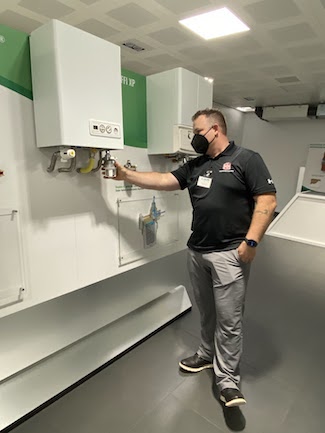
Eric admiring some components not yet available in North America used to filter incoming water on a Combi-boiler
Marco believes that success lies well beyond the company, “I think if you are involved in a company, you don’t only need to make money, you also need to create value in the company by making things better for the people and community. That was what my father believed in,” said Marco.
Currently, Caleffi has subsidiary locations in England, North America, Germany, France, Poland, Turkey, Netherlands, Portugal, Slovenia, Brazil and Australia. With these hubs, Caleffi S.p.A. sells its products in more than 90 countries. Caleffi is planning for more international growth and geographical expansion.
Says Marco, “We are currently planning an 80,000-square-meter warehouse expansion. My vision for the future is to see Caleffi in more countries with a much larger group of products to broaden the range of products we currently offer. Right now, our export business is expanding nicely and our branches are well staffed and managed. I see Caleffi continuing to extend its reach.”
I’m sure Francesco Caleffi would have been proud of the direction and leadership of his son, especially over these difficult past two years. Throughout the journey, the future looks bright for Caleffi.
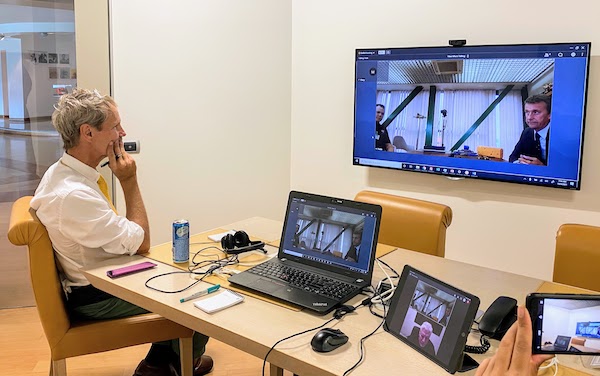
Behind the scenes, Mark Olson sits in on the “virtual” interview with Marco Caleffi by John Mesenbrink.
